Yukgaejang (Korean Spicy Beef Soup)
Yukgaejang is a classic Korean beef soup simmered with shredded brisket, leeks, mushrooms, and chili oil for a deeply satisfying, comforting flavor. It’s hearty enough for a full meal and takes about 2 hours from start to finish, most of it hands-off simmering. Perfect for cozy weekends or whenever you crave a bowl of real Korean comfort.
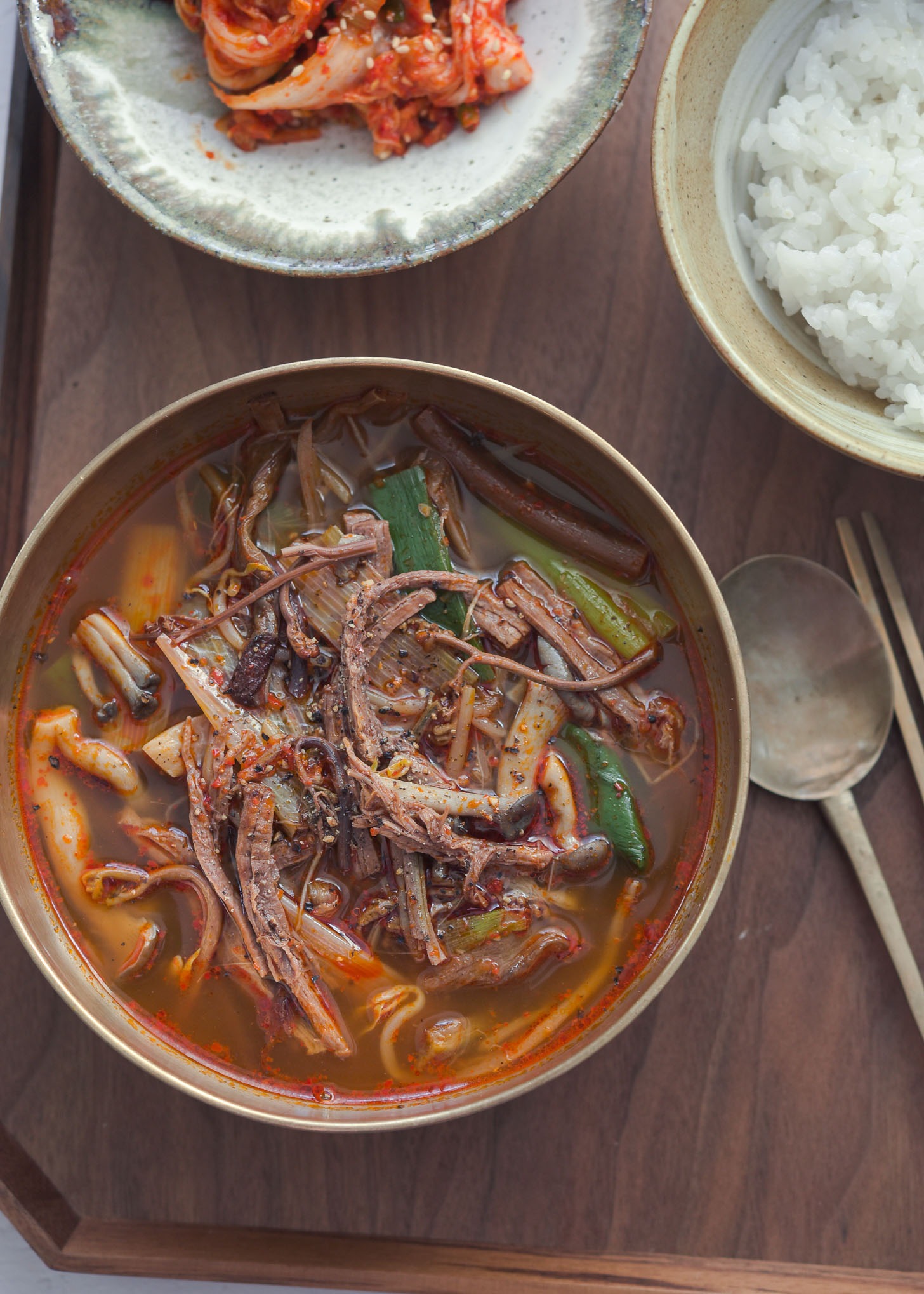
There’s something deeply comforting about a steaming bowl of yukgaejang (육개장), the kind of spicy beef soup that warms you from the inside out. Whenever my mother found a good deal on brisket in winter, she made this spicy beef soup, letting it simmer for hours until the kitchen filled with garlic and chili aroma.
I was lucky to handle the spice even as a kid, so I’ve loved this fiery soup since childhood.

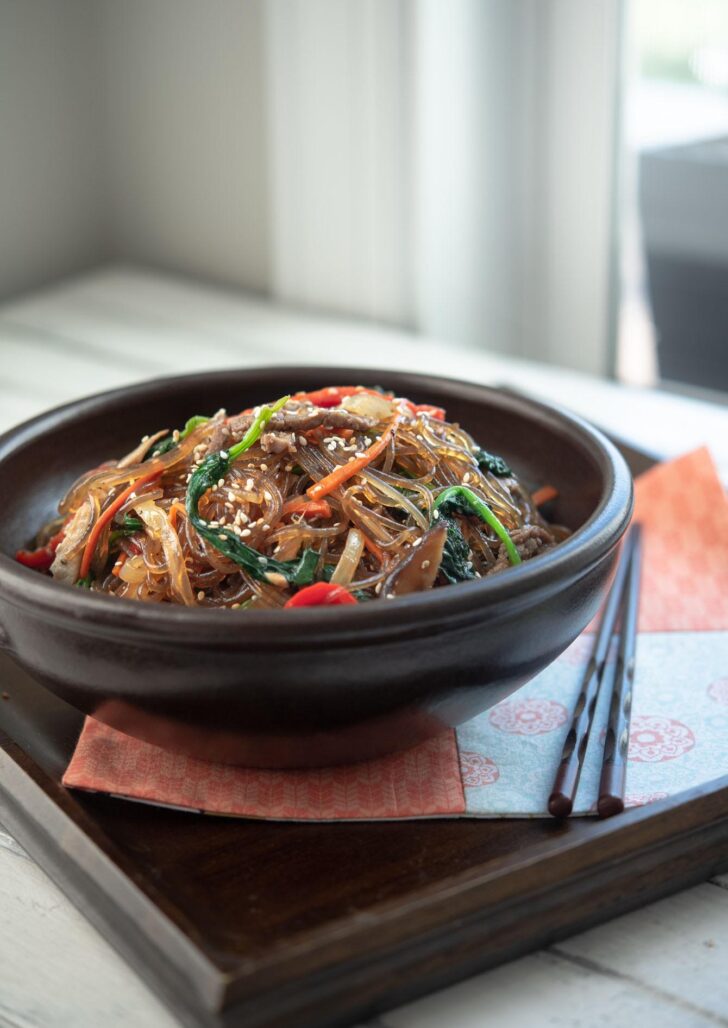
Get new recipes via email:
My version stays true to the traditional method — shredded brisket simmered in a deep red broth with gosari (fernbrake), taro stems, and plenty of leeks. The only twist is my secret trick: a tiny spoonful of gochujang stirred into the broth. It deepens the color and gives the soup just a bit more body without overpowering the classic flavor. Trust me, that small addition makes a big difference.
This isn’t a quick soup, nor is it a beginner’s recipe. It takes time, and a little love — but that’s exactly what makes it special. Each spoonful carries a slow-cooked depth that no shortcut can replicate.
Make a big batch while you’re at it; it tastes even better the next day, and you’ll thank yourself when you reheat a bowl for comfort all over again.
For a chicken version, try my Dakgaejang, the spicy chicken soup. If you need a quick version with simpler ingredients, try my Instant Pot beef stew recipe.
Key Ingredients That Define Yukgaejang
Every Korean home cook has their own way of making yukgaejang, but a few core ingredients always define this classic soup.
Beef (Brisket or Shank): Brisket is the traditional choice because it turns tender and easy to shred after a long simmer. The slow cooking releases rich, beefy depth into the broth — the foundation of yukgaejang’s flavor. Some Korean cooks also use beef shank for a slightly leaner but equally flavorful base.
Gochugaru (Korean Chili Flakes) and Gochujang: Gochugaru gives the soup its vivid red color and smoky, gentle heat. For the best result, I bloom it in oil over low heat to make chili oil — the secret step that infuses every spoonful with warmth and aroma. I also recommend a tiny bit of gochujang to add in the broth to keep the redness throughout.
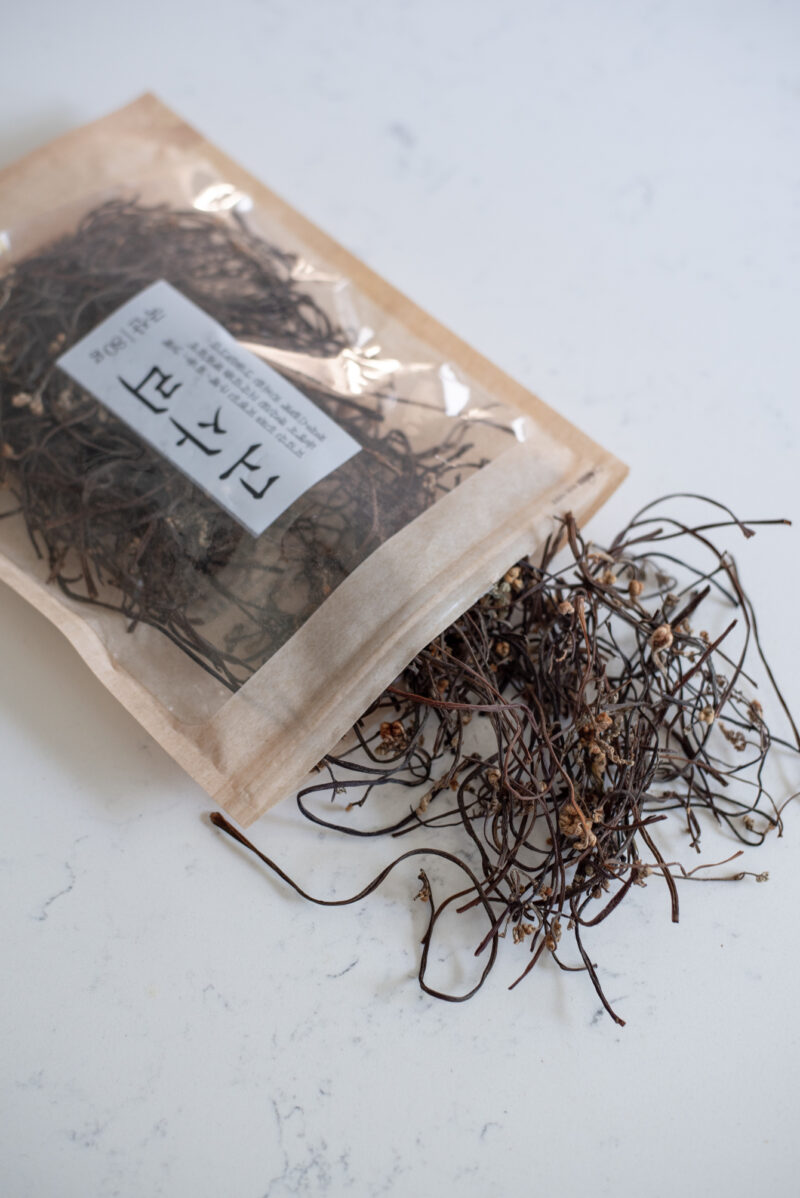
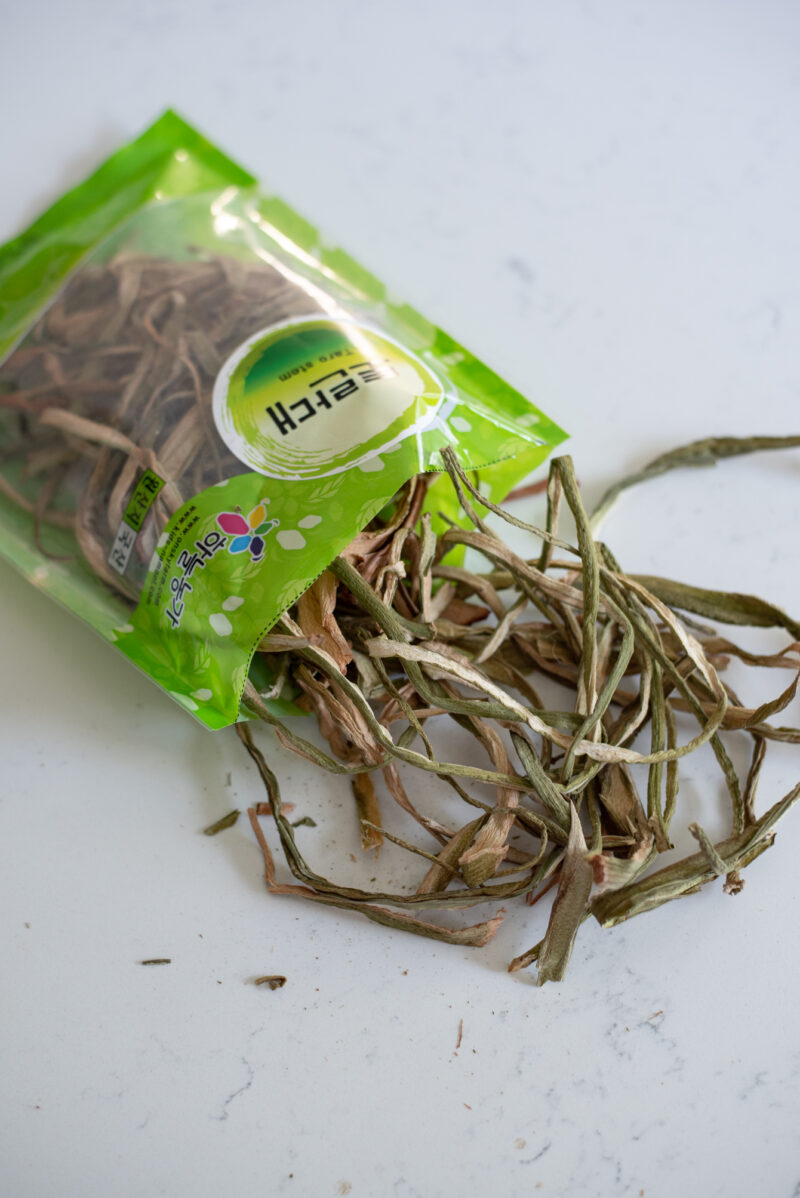
Dried Fernbrake (Gosari, 고사리): Gosari adds a unique earthy flavor and pleasantly chewy texture you won’t find in other soups. It’s a mountain vegetable used in many Korean dishes (like bibimbap), and here it soaks up the spicy broth beautifully. Make sure to rehydrate and simmer it properly for the best texture.
Taro Stem (Toran, 토란대): Toran brings a subtle nuttiness and sponge-like texture that absorbs the broth’s flavor. It’s one of those old-fashioned ingredients that gives yukgaejang its traditional depth. If you can’t find it, you can skip it or substitute extra leeks and sprouts.
Korean Leek, Mung Bean Sprouts, and Mushrooms: These vegetables bring balance and texture to the spicy broth. Korean leeks (daepa) add gentle sweetness and aroma that soften the chili heat, while mung bean sprouts lend a fresh crunch. Mushrooms — especially oyster or shiitake — add savory depth and soak up the rich chili oil beautifully.
Before You Start: Key Prep Steps
Making yukgaejang the authentic way takes patience. Korean home cooks prepare each ingredient separately — simmering the beef, rehydrating the dried vegetables, blanching the fresh ones, and blooming the chili oil. It takes effort, but that’s what gives the soup its deep, layered flavor. Once prepped, the rest comes together quickly
Rehydrating Gosari and Taro Stem
Yukgaejang gets its signature earthy flavor and chewy texture from dried vegetables like gosari (fernbrake) and taro stem (toran). They need a little extra love before cooking.


Bring a pot of water to a gentle boil, add the dried gosari and simmer for about 20 minutes. Remove from heat, cover, and let it soak for another hour until tender. Do the same with the taro stem. Rinse both in cold water several times, then squeeze out excess moisture and cut into bite-size pieces.

These vegetables will expand several times their size, becoming soft yet pleasantly fibrous — the perfect base for soaking up that spicy, beefy broth.
Making the Beef Stock
The deep flavor starts with a simple beef stock — the quiet backbone of every good Korean soup.

In a large pot, combine beef brisket, Korean radish (mu), onion, and whole garlic. Add water and bring it to a gentle boil, then reduce the heat and let it simmer for about 45 minutes.
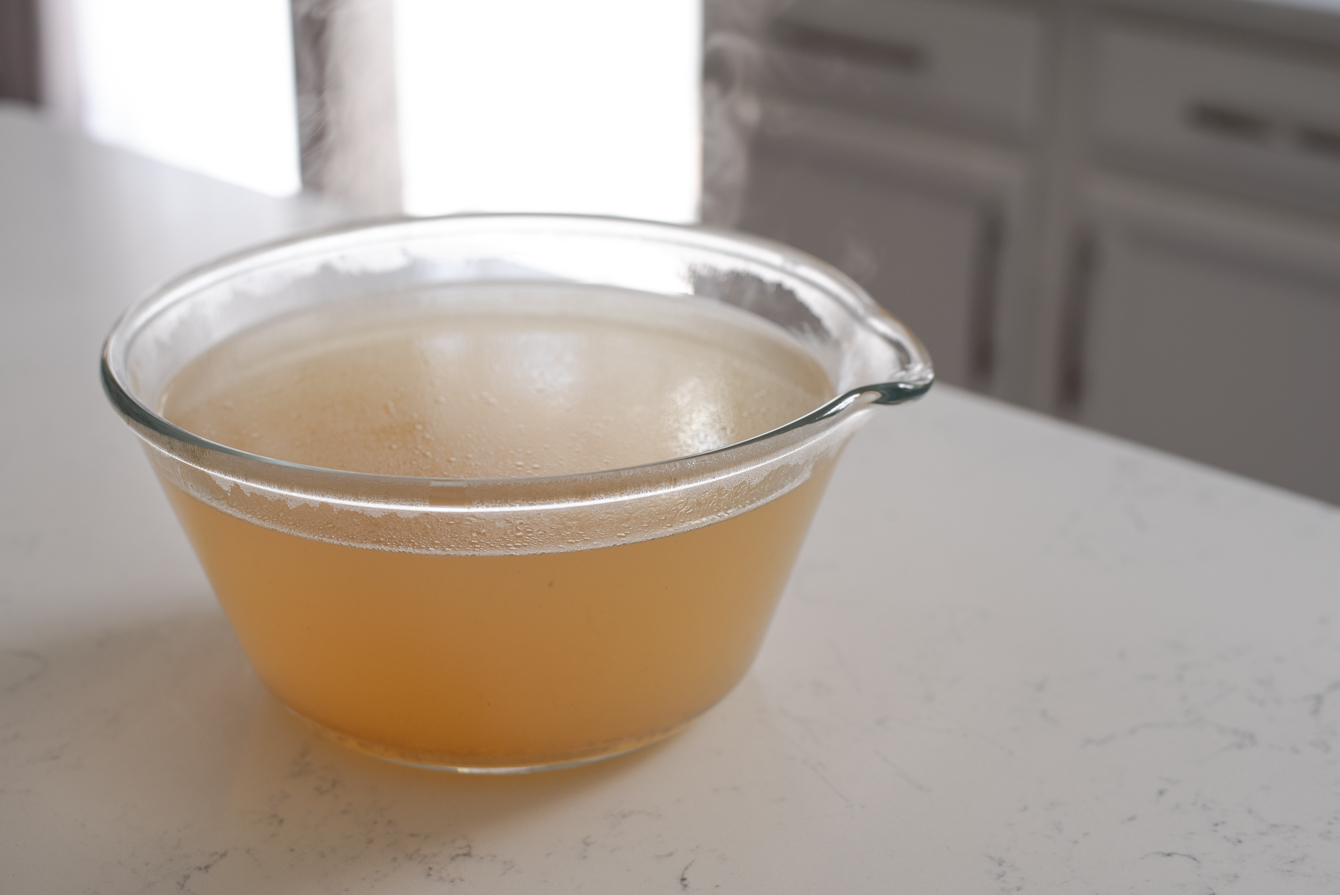
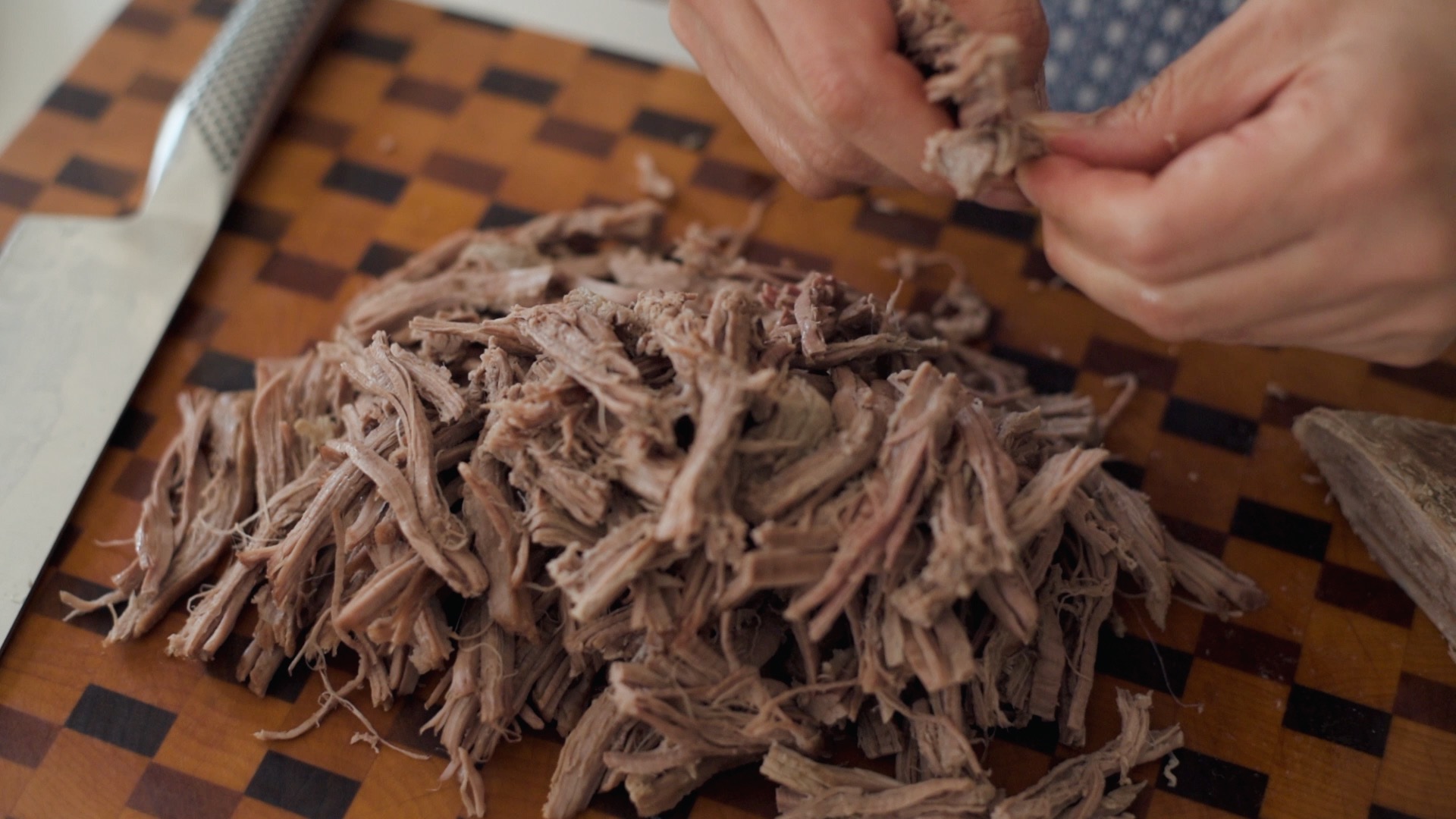
The brisket turns tender and easy to shred, while the radish and aromatics create a clean, savory broth. Discard the vegetables, strain the stock, and set the beef aside to cool before shredding.
Blanching the Vegetables
This quick step keeps the vegetables crisp and clean-tasting so they don’t cloud the broth later.
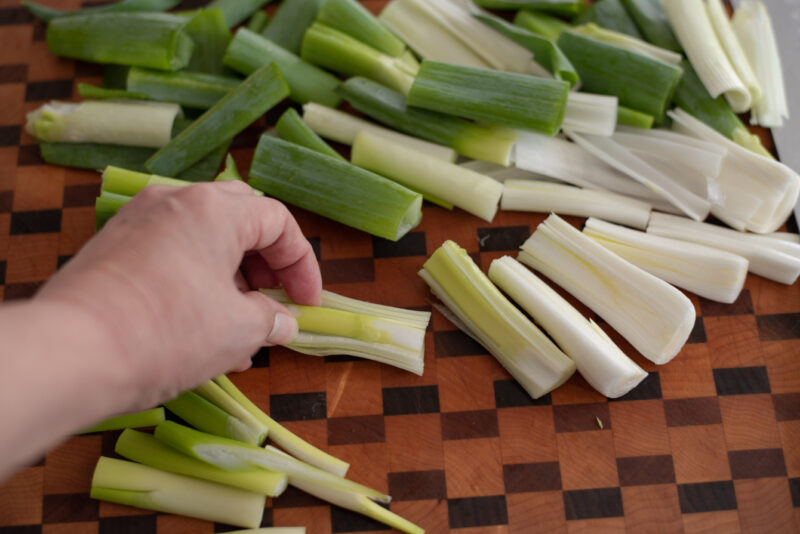
I like to remove the pale green cores from the white parts of the Korean leeks, they tend to be a bit tough once cooked.

The goal isn’t to cook them through but to remove any raw edge or bitterness, adding the perfect contrast to the tender beef and rich chili oil.
Step-by-Step: How to Make Yukgaejang
Once all your ingredients are prepped, it comes together quickly. To see exact measurements and detailed cooking instructions, check the recipe card below.
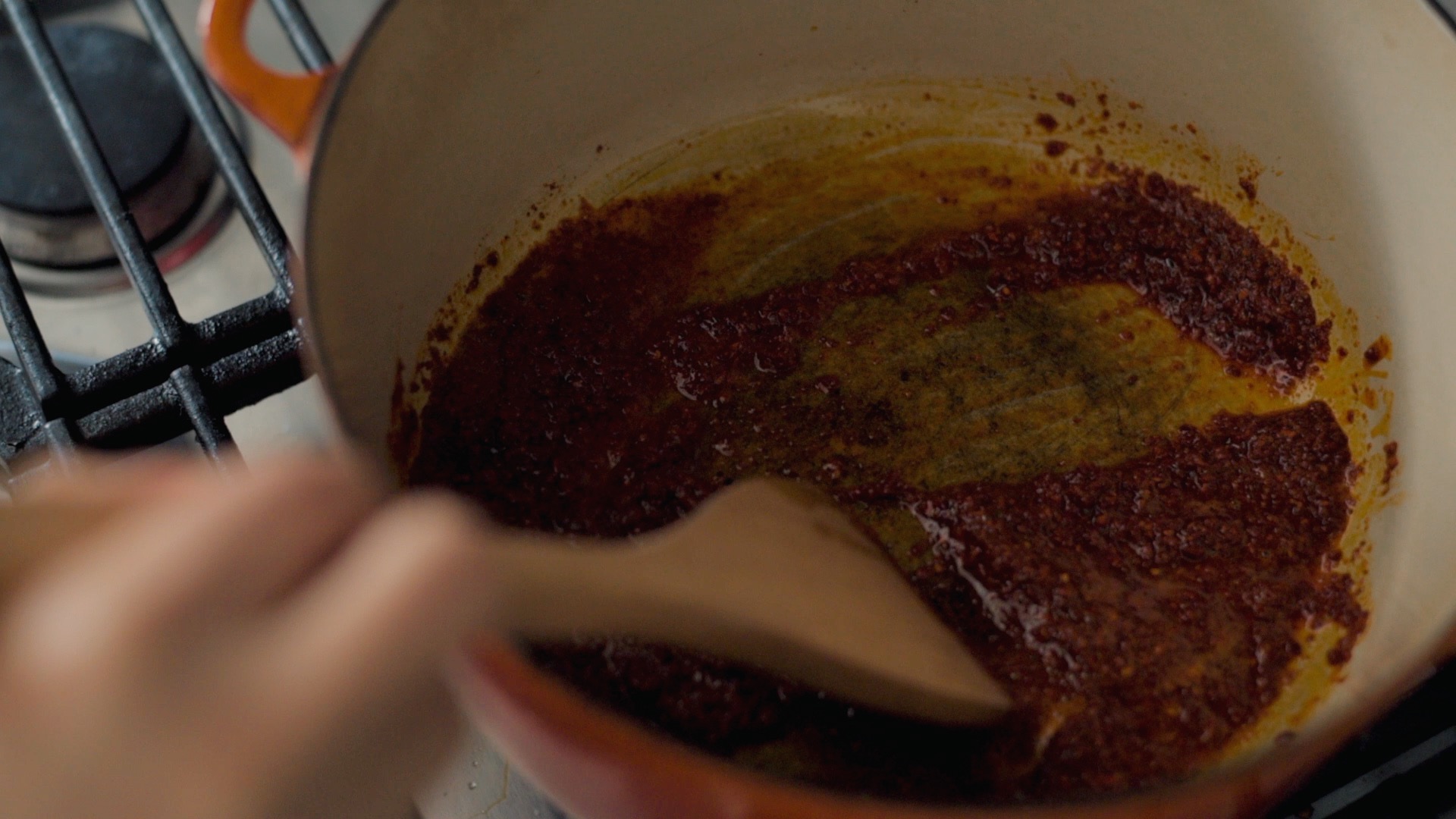
Start by blooming gochugaru (Korean chili flakes) in a mix of oil and sesame oil over gentle heat. This quick step unlocks its deep red color and smoky aroma. Be careful not to burn it; the goal is fragrance, not toastiness.

Next, add the shredded beef and blanched vegetables, stirring until they’re evenly coated in the chili oil.

When you pour in the rich beef stock, the soup instantly takes on that signature deep red hue.
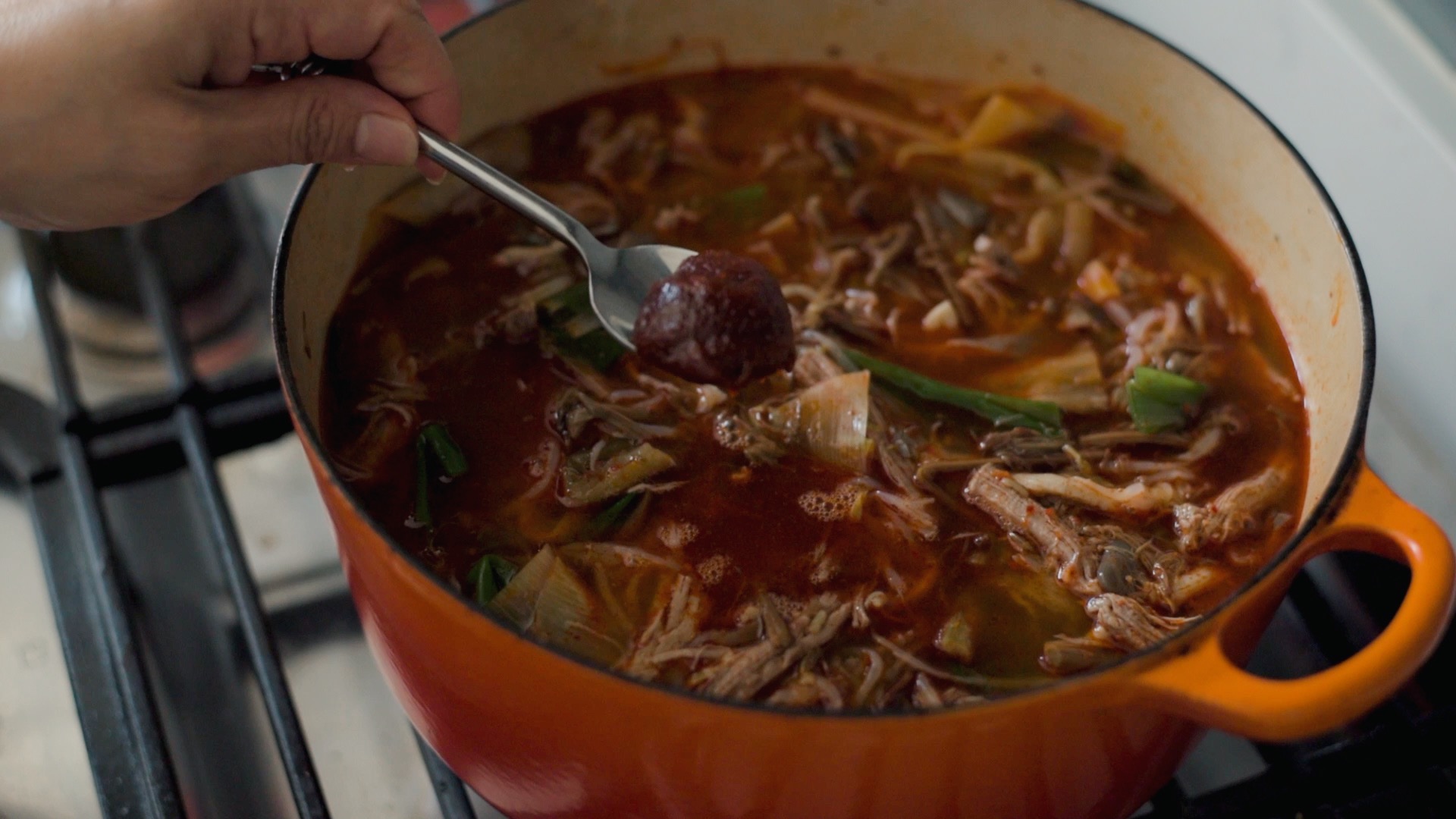
A small spoonful of gochujang (chili paste) adds body and keeps the color vibrant without overpowering the broth. Simmer gently until everything comes together.
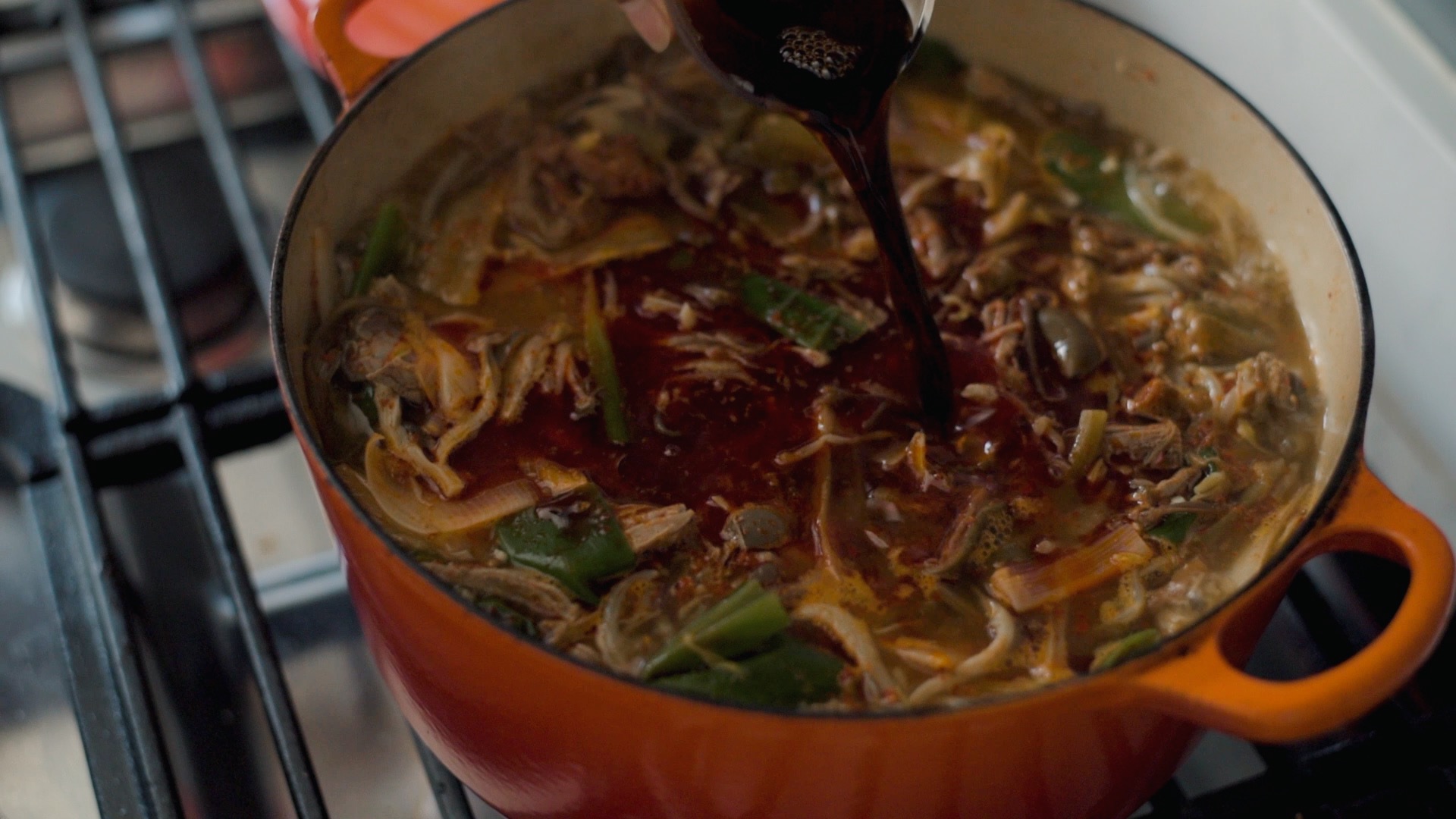
To finish, season with soy sauce, Korean soup soy sauce, and anchovy sauce. Each one adds a different layer of saltiness and umami.

Don’t forget plenty of black pepper. Yukgaejang should have that subtle peppery heat that lingers at the end.

Serving and Storage Tip
Yukgaejang is best served piping hot with a bowl of steamed rice and a few side dishes like kimchi or kkakdugi (radish kimchi). Some people mix the rice right into the soup, while others take spoonfuls of rice between bites — both are completely traditional.
Like many Korean soups, yukgaejang tastes even better the next day. As it rests, the flavors deepen, the heat softens, and the beef becomes wonderfully tender. Store leftovers in the refrigerator for up to a week, or freeze portions for up to 3 months. Reheat gently over medium heat so the broth stays rich and clear.
For a lighter variation, I also share a simplified yukgaejang in my cookbook Korean Cooking Favorites — a quick version made with leeks for a cleaner, faster broth. And whenever you’re in the mood for more cozy Korean soups, you can explore my Korean Soups & Stews category.
This recipe was originally posted in December 2012. I’ve updated the recipe with a few changes, new photos, and more information.

Love this recipe? Rate it and share your experience in the comments below! On Instagram? Tag me to showcase your creation. For more delicious recipes, subscribe to our newsletter!
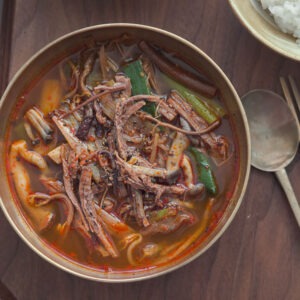
Yukgaejang (Korean Spicy Beef Soup)
Recipe Video
Ingredients
For beef soup
- 0.8 oz (22g) dried fernbrake
- 1 oz (28g) dried taro stem, optional
- 8 oz (225g) mungbean sprouts
- 5 oz (140g) oyster mushroom, or shiitake mushroom, torn into bite size pieces
- 2 Asian leek
- 3 cloves garlic, minced
- 1 tsp (5 ml) Korean chili paste (gochujang)
- 1 tbsp (15 ml) soy sauce
- 3 tbsp (45 ml) Korean soup soy sauce (gukganjang)
- 1 1/2 tbsp (22 ml) Korean anchovy sauce
- salt and pepper, to taste
For beef stock
- 1 1/4 lb (560 g) beef brisket
- 1 large onion , cut in half
- 1 whole garlic , cut in half
- 1/2 lb (225g) Korean radish, cut into large chunks
- 14 cups (about 3 liter) water
For chili oil
- 2 tbsp (30 ml) oil
- 2 tbsp (30 ml) sesame oil
- 3-4 tbsp (30–40 g) Korean chili flakes (gochugaru)
Equipment
Instructions
- To rehydrate the dried vegetables:Add the dried fernbrake (gosari) to a pot of water and bring it to a gentle boil. Simmer for about 20 minutes, then remove from heat, cover, and let it soak for 1 hour until tender. Repeat the same process with the dried taro stem (toran). Drain both vegetables, rinse several times in cold water, and squeeze out excess water. Cut into 2-inch (5 cm) pieces. The texture should be soft yet slightly chewy.
- To make the beef stock:In a large stockpot, combine the beef brisket, onion, garlic, and Korean radish. Add 14 cups (3.3 L) of water and bring to a boil. Reduce the heat and simmer gently for 45 minutes, skimming off any foam. Remove the beef and discard the vegetables. Strain the broth through a fine mesh sieve, then set aside. Once the beef is cool enough to handle, shred it into bite-size pieces. The broth should taste clean and rich — simmer a little longer if it tastes flat.
- To blanch the fresh vegetables:Slice the Korean leeks (daepa) in half lengthwise and cut into 2-inch (5 cm) pieces. I like to remove the pale green core from the white part since it can get tough once cooked. Bring a large pot of salted water to a boil, add the mung bean sprouts, and blanch for about 10 seconds. Add the mushrooms and leeks and blanch together for 10 more seconds. Drain and rinse under cold water, then squeeze gently to remove excess water.
- To make the soup:Heat the oil and sesame oil in a large pot over low heat. Add the Korean chili flakes (gochugaru) and stir gently for about 30 seconds until fragrant — don’t let it burn. Add the shredded beef and blanched vegetables, stirring well to coat everything evenly in the chili oil. Pour in 8 to 10 cups (2–2.4 L) of the reserved stock, depending on how thick you prefer the soup. Stir in a teaspoon of gochujang to enhance the color and depth of flavor. Cover and simmer for 15–20 minutes over medium-low heat. Season with soy sauce, Korean soup soy sauce (gukganjang), and anchovy sauce. Taste and adjust salt if needed, and finish with plenty of black pepper before serving.

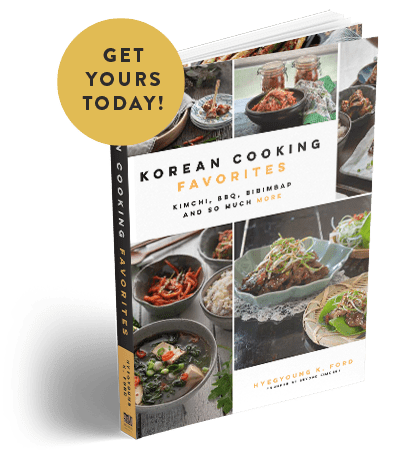
My wife is Korean. She’s been making yukgaejang for 40 years, and this recipe is very close to hers. The only thing wrong with the recipe is its title. If you try saying “yukgaejang” using standard English, it sounds like “yuck-gay-jang” (rhymes with “gang”). Why not use “yook-keh-jahng”? Any grade-school student can say yook-keh-jahng, but you have to learn a new system of pronunciation in order to say yukgaejang correctly. It’s easier to learn hangul than to learn Korean Romanization.
Yook keh jahng? I think the way Holly did it is just fine. That’s the way I spell it
in English too. I definitely would NOT spell it “keh” . It’s more of a g sound than a k sound.
I agree with your comment about the “g” in “geh”, but most Americans will pronounce “yuk” as “yuck”, the word for something distasteful. The general rules of English pronunciation and spelling wouldn’t produce an “oo” sound between “y” and “k” unless there were a silent “e” afterward, as in “juke” and “duke”. And the “ae” spelling will nearly always produce a long “a”, and “jang” will produce a short “a” as in “rang” (My wife’s given name is “Hyang-Jin”, and when she spelled it that way, people invariably said “hyang” to rhyme with “bang”, “sang”, and “gang”. Yukgaejang, for people unfamiliar with the word, will produce yuck-gay-jayng. (In case it isn’t obvious, I seriously disagree with most attempts to Anglicize hangul. It’s much easier to learn hangul — which people often pronounce hang-gull — then to invent a new set of rules for English spelling.)
Wow! Never heard of this dish before, but would love to try. It looks so hearty and comforting and I know hubby and I would enjoy it!
It is a comforting stew, especially for those who loves spicy stews. Tasty!
I’m not familiar with Yukgaejang, but it sounds absolutely fantastic! I love beef stew, and I enjoy spicier cuisine on occasion. I definitely need to try this! Interesting note about eating this on a hot day – I can’t say that it would be my first choice, but I do see the logic. For me, this sounds like an excellent dinner on a chilly Autumn day! Plus, it uses brisket, and I almost always smoke my briskets…fun way to use brisket in a different style.
If you like spicy food, you will definitely love this stew.
I know what you mean. It’ is not my first choice to eat hot soup in the middle of summer heat, either. It is, indeed, a great soup for the cold season, too.
Lots of work…but it turned out looking really tasty and flavourful. So definitely worth all of the efforts!
It takes time, but it’s so worth it. the leftover tastes even better on the next day.
Hi holly, love your recipes! I just got an instant pot (electric pressure cooker) and was wondering if you knew how to cover the cooking times and steps to make this in a pressure cooker instead of on the stove? Thanks!
I would reduce the amount of stock by 2/3, and the reduce the cooking time according to the soup setting.
Hi Holly,
thank you for this recipe. It is a great starting point for me 🙂
I have to nitpick about you bringing up and those taro stems, though…
My mother told me that, originally, taro stems were never used here. It used to be Goguma stems, but unfortunately, they are hardly available anymore – even in Korea (!).
So… the king would probably had had goguma stems. I suppose the story adapts wonderfully 😛
Kind regards
Hi Holly! Been following ur recipes a lot! My household is really small so i wanna ask if i can store this gorgeousness in the fridge or something?
Hi Mion
Yes, you can store the leftover in the fridge and reheat it over the stove or in a microwave. Hope you like it.
Thank u for the reply Holly! May i know how long does it keep?
It will last up to 10 days in the fridge. It might taste good even after, but be cautious.
Thanks for the recipe and story behind yukaejang – very touching! I look forward to trying your recipe – I never knew how to make that “red” soup color; mine is a much more simple version. Thanks for your great blog, recipes, and stories – much more accessible than the Korean cookbook my mom gave me 🙂
I’ve been looking so hard to find a perfect recipe of Yukgaejang. When I first tried this dish at a Korean restaurant, I instantly loved it. So I’m gonna try this soon.. I also told my boyfriend about me trying this recipe so he’s kind of excited as well. 🙂
Hi Isa
Hope you enjoy this recipe. Your boyfriend is a lucky guy! ^^
OMG! This is my favorite Korean soup. I have to try this recipe!! Thank you!
probably my all time favorite korean dish. i could eat this 24/7/365.
Wow, this must be your true love! Thanks for the comment, Erik!
Looks so good, can’t wait to try! I don’t think many people realize how inexpensive these Asian food ingredients can be at Asian markets. Well at least here in San Diego there are many different markets to choose from!
First off, I just want to say that I love your blog, and I have bookmarked it. Your stories and recipes are fantastic! After having spent about 2 hours searching, reading and getting very hungry, this stew looks like the dish I’ll try making first… I LOVE spicy food! 🙂 Having read your entire tutorial on kimchi, I think that might be a bit more than I can handle for the first Korean dish I make. lol This stew looks wonderful, and I have a Korean co-worker I’d love to take some to. In this recipe, you said you substituted oyster mushrooms for the taro stem. I am a cashier at a large Houston grocery store where occasionally I have seen taro stems come through my register. Never knew what they would be used for until now! If in fact I can get my hands on taro stem, how much would I need for this recipe, and how would I prepare it for the stew? Also, is there a substitute for fiddleheads in case I cannot find them?
Hi Rebecca
Thanks for the sweet comment. I am glad that you enjoy reading my post. This particular stew is really great for cold weather days. I hope you get to enjoy making it. It is exciting to hear that you have an access to taro stems. if they are fresh, just blanch in a boiling water until soft, then add to the other mixture for seasoning. If dried, you need to soak overnight and boil in the water until soft.
For the substitution of fiddle head, it is sort of one of the most important ingredient next to the beef, but if you can’t find them, try with swiss chard. Let me know how it turns out.
This looks delicious!
Are the fiddleheads the same as what we get in North America in the spring?
Not all the fiddleheads are created equal I guess. They look a little different but you can still use them in the recipe.
Thanks so much for this recipe…I’m South Korean myself and adopted, and i love korean food but i’m trying to research myself about korean food since i didn’t have a korean upbringing. I always ordered this dish in restaurants but i didn’t know what the fiddlehead was! i’m going to try and find this at my local asian supermarket now i know what i’m looking for. thanks again for the story and inspiration!
Oh Holly, I love your stories that come with your food! So what happened to the King after he ate his stew and understood the meaning? I will try and find that film, hope I can find a version with Eng subtitles! Lol
The stew looks fabulous and I can’t wait to try it 🙂
Hi Lucy
I think the king died soon after in the movie. But in real history, he lived 10 or more years and secretly supported resistance groups for the country to bring the independence. It is very interesting movie about food and I really enjoyed. Hope you get to find.
Ah… I love yukgaejang and have been patiently waiting for your version, Holly. Can’t wait to make it myself!
Thanks. It was really tasty and spicy! Hope you get to try soon.
I really enjoyed learning about some of the symbolism behind this dish–very interesting and very beautiful. Not to mention that it looks really delicious!
I just finish making this. Soooo good, soooo spicy, I am like your son, needed lots of water but the spiciness just makes you want to eat more, I don’t know if there will be leftovers for tomorrow: )
I’m reading this on a cold winter morning and it looks SO GOOD. Gorgeous recipe and I love the story about your son’s Pakistani friends. Adventurous eaters warm my heart!
Oh boy, does that look delicious! Yukgaejang was my all time favorite dish growing up. When going to Korean BBQ restaurants, I would actually prefer ordering this over galbi even, and nobody ever understood why. I dont get to eat this dish much these days, but I should making your version sometime. Thanks for the recipe.
Hi Mike
I don’t get to eat much of this stew often either. It is good, isn’t it? I love old time favorite food and Yukgaejang is great comfort food for most Koreans. Thanks for your comment.
Great story! And great stew! Good tip on the fiddleheads – I rarely see them in markets here, but didn’t realize they were common in Korean cooking. Now I know where to look. BTW, Pakistani food can sometimes be fiery hot! We used to have a friend who was Pakistan, and we were at her house one day with some other friends who were Indian. Our Indian friends has perspiration beading their foreheads as they were eating lunch because they found the food so hot! My wife and I had no problem. But at the time we were seriously into spicy food. Anyway, good post – thanks.
Thanks Holly for this recipe. I tried following another site’s recipe but it just did not taste right. Can’t wait to try this!